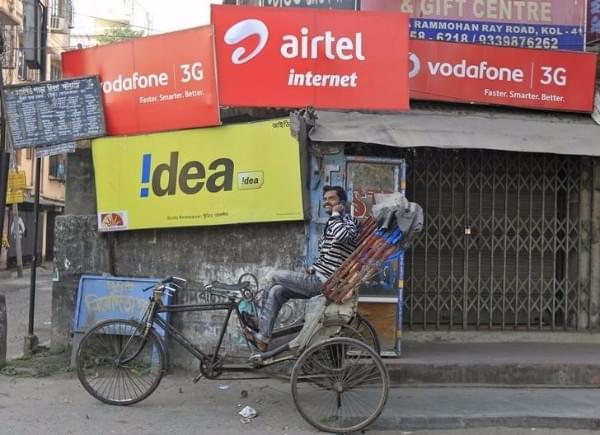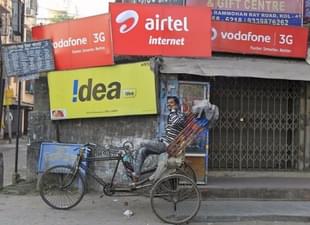Economy
Why Hyper Competition Is Good For Incumbent Telecom Companies And Consumers
Sindhu Bhattacharya
Nov 29, 2017, 04:13 PM | Updated 04:13 PM IST
Save & read from anywhere!
Bookmark stories for easy access on any device or the Swarajya app.


India’s telecom sector has seen rapid and unprecedented consolidation after the entry of Reliance Jio Infocomm last year. From a peak of almost a dozen operators, the market is eventually expected to settle down with less than half a dozen as mergers and acquisition (M&A) activity closes. Smaller operators are in the process of completing their mergers with the large ones while a mega telecom operator in the form of the merged Vodafone-Idea entity is also taking shape.
Even today, just three operators control two-thirds of the industry’s total revenue pie while the remaining third is scattered between as many as eight operators. If one combined Reliance Jio with the big three, then the top four operators together control three-fourths of the revenue market share.
Also, the revenue market share of the incumbents has increased despite Jio’s entry, though this has happened on a smaller overall revenue pie. Sunil Mittal, the chairman of market leader Bharti Airtel, has said to the Economic Times that Airtel has been a beneficiary of this market consolidation. “Revenue market share is increasing, albeit on a revenue pie which has shrunk. Vodafone and Idea together will be settling at about 40 per cent. By the time the merger happens, we will be around 37 per cent to 38 per cent with Tata and Telenor. I would say by March FY19, we should be back at No 1.”
So, is the hyper-competitive situation brought about by the entry and subsequent aggressive freebies by Jio eventually going to benefit the incumbents, never mind their constant ‘playing the victim’ card? It has already benefited India’s telecom subscribers through hugely discounted tariffs on data, with voice being bundled for free. In the same ET piece, Mittal said that the incumbents have had to write off “about $40 to $50 billion” due to the current hyper-competitive state. If this estimate is true, benefits of Jio’s entry would seem exaggerated at best.
But sector analysts differ, with many saying the worst may be over for incumbent telecom operators, and some of the smart acquisitions by Bharti anyway negate, to a large extent, the negative fallout of Jio’s arrival. Analysts Srinivas Rao, Peter Milliken and Pei-Yu Looat at Deutsche Bank said in a note to clients earlier this month that their forecast is mobile revenues of $36 billion (8.2 per cent per annum over FY17-20E) and revenue market shares for Bharti at 38 per cent, Vodafone/Idea 38 per cent and Jio 22 per cent. “We believe pricing will progressively normalise, as evident from Jio’s two effective price increases since April 2017. A lower revenue base is a significant operating risk for Jio, which it needs to balance against its revenue-share ambitions. Incumbents' ability to defend their revenue share is stronger than assumed, given their larger spectrum portfolio than Jio’s. The market expects market-share loss for Voda/Idea to the low-30s in favour of Jio, which we see as a low-probability outcome.”
As if anticipating the Bharti chairman talking about large-sector write-offs, these three analysts said in November that Bharti has “effectively recouped” the $1.5 billion per annum mobile EBITDA (earnings before interest, taxes, depreciation and amortisation) decline due to Jio’s entry via the acquisition of two competitors Uninor and Tata Teleservices at distressed valuations and spectrum relative to the others. “This would result in a 7 per cent revenue share gain (currently 32 per cent) and a robust pan-India spectrum portfolio of 1,850 MHz. Our forecasts imply a revenue share of 38 per cent by FY20E and a 40 per cent mobile EBITDA margin. Thus, Bharti’s mobile EBITDA could double by FY20E to $5 billion from the current run-rate of $2.5 billion”.
So how are big incumbent telecom companies able to grow their revenue shares despite such stiff competition from Jio? Partly due to robust cost management and partly because of smart acquisition strategies. The Deutsche Bank analysts note that despite a rapid increase in 4G footprint, Bharti and Idea’s non-regulatory costs have remained flat over the last five quarters. The increase in spectrum portfolio would also help to reduce capex intensity in the medium term.
But in the near term, the pain will continue. Analysts at IIFL Institutional Equities point out that year on year, the telecom industry lost about 15 per cent revenue in the September quarter of the current fiscal – while the big three lost less, smaller telecom operators lost as much a 30 per cent in revenues over the 12-month period under review.
As explained earlier, in the long term, the Indian telecom market should not only stop losing revenues but the incumbents should be in a much better position to defend their revenue shares. A return of pricing stability is key to this happening. When Mittal was asked whether the return of pricing stability is still some time away, he said, “Yes. But if there are only three people serving a billion people, cut it whichever way you want, it (telecom sector) is a strong play.”
Moral of the telecom story is that sector consolidation, even if it comes about because of hyper competition by a new, aggressive player, is mostly a good thing. It helps strengthen the balance sheets of companies in fray and also lessens the tariffs for consumers.
Sindhu Bhattacharya is a senior journalist.





